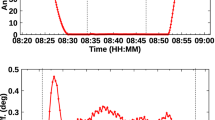Abstract
This paper analyzes the problem of autonomous control of the longitude of the ascending node (LAN) for a satellite in low Earth orbit (LEO) by means of along-track and anti-alongtrack velocity increments which adjust the semimajor axis. The problems related to the possibility of generating the reference orbit (RO) on-board and with the estimation of the atmospheric drag are considered. The Autonomous Orbit Keeping (AOK) experiment of the PRISMA formation flying mission will be the test platform of the control strategy here exposed. The AOK on-board software shall demonstrate autonomous orbit control using a guidance law for the orbit’s LAN and shall implement a deterministic control algorithm using along-track and anti-along-track velocity increments. Using GPS-based absolute navigation data, AOK shall command thruster activations in the orbital frame to autonomously control the orbit within a predefined window. The AOK experiment paves the way to the accurate and autonomous orbit control of LEO satellites on a routine basis. The main requirement of the experiment is to demonstrate an orbit control accuracy of the osculating ascending node of 10 m (1σ). The paper shows results from real-world software simulations where the accuracy of the reference orbit is limited and GPS sensors and hydrazine actuators are accurately modeled. The fundamental approach on which the software design, validation and testing is based, is also explained.
Similar content being viewed by others
References
WERTZ, J. R. “Autonomous Navigation and Autonomous Orbit Control in Planetary Orbits as a Means of Reducing Operations Cost,” Proceedings of the 5th International Symposium on Reducing the Cost of Spacecraft Ground Systems and Operations, Pasadena, CA USA, July 2003.
KUDRYAVTSEV, S. and GILL, E. “Autonomous Orbit Control of Remote Sensing Spacecraft using Spaceborne GPS Receivers,” DLR-GSOC, TN 00-06, December 14, 2000.
D’AMICO, S., ARBINGER, C., KSNIRSCHNER, M., and CAMPAGNOLA, S. “Generation of an Optimum Target Trajectory for the TerraSAR-X Repeat Observation Satellite,” Proceedings of the 18th International Symposium on Space Flight Dynamics, Munich, Germany, October 11–15, 2004.
ARBINGER, C., D’AMICO, S., and EINEDER, M. “Precise Ground-In-the-Loop Orbit Control for Low Earth Observation Satellites,” Proceedings of the 18th International Symposium on Space Flight Dynamics, Munich, Germany, October 11–15, 2004.
ROSENGREN, M. “The Orbit Control of ERS-1 and ERS-2 for a Very Accurate Tandem Configuration,” RBCM, Vol. XXI Special Issue, 1999, pp. 72–78.
ROSENGREN, M. “Improved Technique for Passive Eccentricity Control,” presented as paper AAS 89-155 at the AAS Symposium on Mission Design and Orbital Mechanics, 1989.
PERSSON, S., BODIN, P., GILL, E., HAR, J., and JÖRGENSEN, J. “Prisma: An Autonomous Formation Flying Mission,” Sardinia, Italy, Proceedings of the ESA Small Satellite Systems and Services Symposium (4S), September 25–29, 2006.
GILL, E., D’AMICO, S., and MONTENBRUCK, O. “Autonomous Formation Flying for the PRISMA Mission,” Journal of Spacecraft and Rockets, Vol. 44, May 2007, pp. 671–681.
D’AMICO, S., GILL, E., GARCIA, M., and MONTENBRUCK, O. “GPS-Based Real-Time Navigation for the PRISMA Formation Flying Mission,” Proceedings of the 3rd ESA Workshop on Satellite Navigation User Equipment Technologies—NAVITEC, Noordwijk, December 11–13, 2006.
LAMY, A., CHARMEAU, M.-C., LAURICHESSE, D., GRONDIN, M., and BERTRAND, R. “Experiment of Autonomous Orbit Control on the Demeter Satellite,” Proceedings of the 18th International Symposium on Space Flight Dynamics, Munich, Germany, 2004.
LAMY, A., CHARMEAU, M.-C., and LAURICHESSE, D. “Experiment of Autonomous Orbit Control on the Demeter Satellite: In-Fight Results and Perspectives,” Proceedings of the AIAA Astrodynamics Specialist Conference, Keystone, Colorado, August 21–24, 2006.
xPC Target 3 -Users Guide, The MathWorks, March 2008.
GAISLER, J. The LEON Processor User’s Manual V2.3.7, Gaisler Research, 2001.
RTEMS C. Users Guide. Edition 4.6.5, for RTEMS 4.6.5, On-Line Applications Research Corporation (OAR) http://www.rtems.com, August 30, 2003.
LIU, J. “Satellite Motion about an Oblate Earth,” AIAA Journal, Vol. 12, November 1974, pp. 1511–1516.
MONTENBRUCK, O. and GILL, E. Satellite Orbits—Model, Methods and Applications, Heidelberg: Springer Verlag, 2000.
MICHEAU, P. Spaceflight Dynamics, Vol. I, Ch. Orbit Control Techniques for LEO Satellites, Toulouse, France: Cepadues-Editions, 1995.
D’AMICO, S., FLORIO, S. D., and YAMAMOTO, T. “Offline and Hardware-in-the-Loop Validation of the GPS-based Real-Time Navigation System for the PRISMA Formation Flying Mission,” Proceedings of the 3rd International Symposium on Formation Flying, Missions and Technology, ESA/ESTEC, Noordwijk, The Netherlands, April 23–25, 2008.
Author information
Authors and Affiliations
Rights and permissions
About this article
Cite this article
De Florio, S., D’Amico, S. The precise autonomous orbit keeping experiment on the PRISMA mission. J of Astronaut Sci 56, 477–494 (2008). https://doi.org/10.1007/BF03256562
Published:
Issue Date:
DOI: https://doi.org/10.1007/BF03256562




